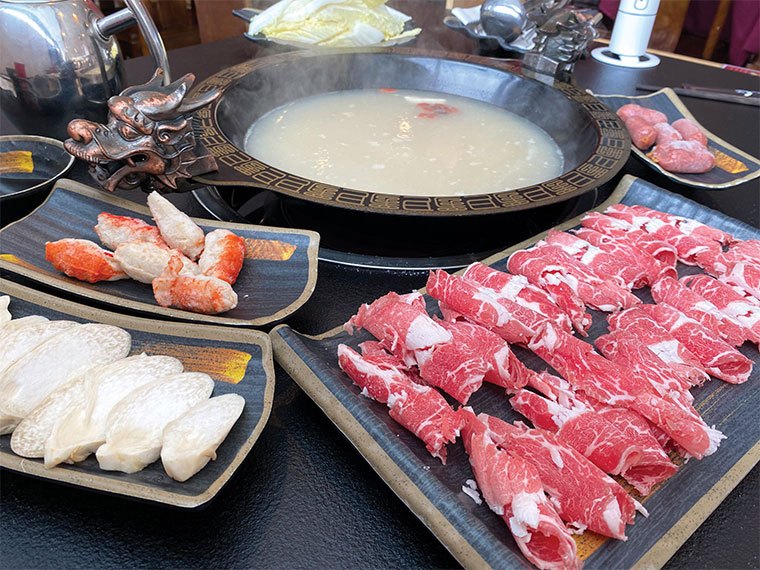
Mahalo for supporting Honolulu Star-Advertiser. Enjoy this free story!
Cantonese restaurants have such a long-standing history in the islands that diners are accustomed to find the same dishes from place to place, from sweet-sour pork to salt and pepper shrimp, and, of course, the thin pan-fried soy sauce noodles, chow mein.
Outliers like Eat on Time keep things interesting. The latest restaurant to offer the cuisine of Guangdong province is like two restaurants in one, offering both an ample hot pot menu and an a la carte menu of family-style appetizers, soups and entrées. The restaurant hasn’t adopted the local lingo of its competitors, so unless you can read hanzi, there may be moments when a dish doesn’t resemble anything you imagined. Dishes are more mundane than imaginative foodies may believe from reading the menu.
That’s not necessarily a bad thing. Once you get past language, those who love the tried-and-true fare will be mightily pleased. On the a la carte half of the menu, the food is fresh and clean tasting, without much of the saltiness and oil associated with Chinese food.
Given a degree of cultural confusion, I thought a dish of chicken balls with vegetables ($13.50) might be interesting, imagining chicken meatballs on par with tsukune. Quizzing a waitress was no help because with a language barrier she simply confirmed my thought. The dish that arrived was simply diced chicken with broccoli. It was delicious but from a foodie’s perspective, with a quest for the new, more basic than expected.
When hearing the word “yam,” I think most local people would assume a reference to sweet potato, so a dish of pan-fried yams with wood ear ($16.50), the black tree fungus, intrigued me because I often seek out yams for their nutrition content. It wasn’t the medicine I was expecting, but turned out to be jicama — such an ubiquitous ingredient in Chinese cuisine that it’s more familiarly known as the chop suey yam. My confusion arose because these yams are never given top billing on a menu; they merely appear as a side player, adding texture to a dish. These yams have a crunch similar to water chestnuts and were stir-fried with the equally crunchy tree fungus and snow peas. On most menus, this dish would be described as stir-fried snow peas.
Superior Sou Pan Fried Noodles ($11.50) were no more than basic chow mein, drier than many local counterparts. And Jingdu ribs ($14.50), a reference to the Chinese capital Beijing, was a standard dish of sweet-sour pork ribs, in the Beijing style more sweet than sour.
If you’re new to the restaurant, it’s probably best to stick to standard dishes that leave no question as to what they are, such as cold chicken with ginger and onion sauce ($13.99 half, $27 whole), pepper salt pork chops ($14.50) or shrimp ($17.50), broccoli with beef ($14.50) or honey walnut shrimp ($17.50). I was delighted by the legit Sichuan flavor they brought to fish fillets in hot chile oil ($23), full of tongue-numbing Sichuan peppercorns.
I was initially drawn to this restaurant for its hot pot because, with Little Sheep closed, I’ve been wanting to find a comparable restaurant. The menu here is much smaller and pandemic restrictions take the fun out of customizing your own sauce from multiple ingredients provided. Here, they give it their best shot by bringing to the table small amounts of nine ingredients ranging from the liquid — chile sauce, sesame paste, briny sa cha and shoyu — to semisolid fermented tofu, plus green onions, garlic and cilantro. You can always ask for more of your favorites.
There is no charge to start with their original bone broth. There are three other selections that will cost you. A rice soup base is $5, Sichuan spicy soup is $9 and herb chicken soup is $18. It’s OK to start with the most basic because your customized sauce will give your boiled ingredients all the flavor you need.
Popular items you can add to your hot pot start with thin-sliced beef ($13), pork ($14), lamb ($14) and beef tongue ($18). You can try your luck with more exotic fare like fish stomach ($6) and beef aorta ($9). There’s a rather lengthy list of items that have disappeared over time because they don’t resonate with the local audience. Vegetable options include king oyster mushrooms ($5) that possess a wonderful meaty texture the compliments other ingredients, a handful of greens ($3-$5), bean curd ($3), sliced lotus root ($5) and pumpkin ($3).
Some items arrive still icy from the freezer, including crab sticks (fishcake, $3), Fujian mini meat-filled dumplings ($5) and sweet Chinese-style mini sausages ($4).
It may take you a few attempts to find your bearings with Eat on Time’s menu, but once you do, it may become your go-to place for the most contemporary Guangdong cuisine available on Oahu.
Eat on Time
1296 S. Beretania St., Honolulu
(outside Times Supermarket)
Food: ***
Service: ***
Ambiance: ***½
Value: ***½
Call: 808-593-8055
Hours: 10 A.M.-9 P.M. daily
Prices: About $50-$60 for two to four
Nadine Kam’s restaurant visits are unannounced and paid for by Honolulu Star-Advertiser. Follow Nadine on Instagram (@nadinekam) or on YouTube (youtube.com/nadinekam).
"eat" - Google News
August 04, 2021 at 10:30AM
https://ift.tt/3jjzLmL
Time to eat - Honolulu Star-Advertiser
"eat" - Google News
https://ift.tt/33WjFpI
https://ift.tt/2VWmZ3q
Bagikan Berita Ini














0 Response to "Time to eat - Honolulu Star-Advertiser"
Post a Comment